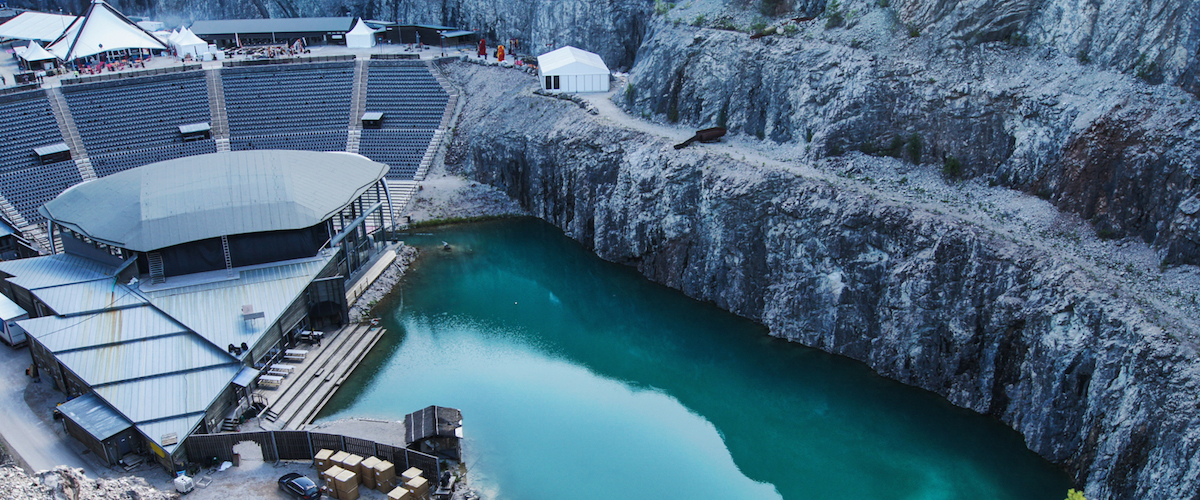Photo Gallery and Review: Into the Valley
XLR8R spent a weekend in the Swedish countryside at the second edition of the festival.

Sweden’s modern electronic scene is a curious thing. There aren’t many comparable ones out there that look and sound so distinctive—deep, tasteful tunes produced and consumed by hip and stylish, fresh-faced youths. A week before travelling to Into the Valley, I had spent the night at Aniara’s first Panorama Bar showcase, on a dancefloor that must have made it to roughly four-fifths Swede for most of the night; something to whet the appetite for the Scandinavian nation’s dance scene.
Launched last year, Into the Valley is still an infant in the complete scheme of the European festival circuit, though it somehow already feels old beyond its years. Situated three hours north-west of Stockholm, its site is its key selling point: proceedings take place in Dalhalla, an amphitheatre burrowed into a former limestone quarry, which today typically serves a venue for opera and other musical performances. It’s spectacular to look at (as well as being a real physical commitment to navigate, scaling the breadth and depth of the site to check out attractions).
This year’s event split a condensed who’s who of house and techno across four separate stages. At the heart of the action was the Theatre, a domineering stage burrowed into the bottom of the pit—a platform of stadium techno proportions with a sound system to match, it lived up to the epic scene promised by the media surrounding the event. With pearly blue waters to the back and clear skies above, the performers were framed by the greatest of the great outdoors.
On the Friday of the event, the Theatre was taken over by a host of minimal house’s usual suspects. Having arrived just in time to catch tINI cobbling together a thoughtful, varied selection of bouncy tech-house numbers, it was evident that things moved up a level when Raresh and Sonja Moonear took the reigns, with eager crowds pouring into the pit. The two complemented each other perfectly in what was their first ever back to back session, quickly establishing a rolling groove that culminated in some real rave moments (Cevin Fisher’s peak time dub of “Women Beat Their Men” or Spacetravel’s recent “Magic Track,” for example).
The main event was yet to come—a four hour performance from long-time friends and collaborators Zip and Ricardo Villalobos. As is always the case when they get together, a ceremonial atmosphere loomed, with a sense that something special was being witnessed. As a circus of punters flocked around the pair, they dropped a cool opening one-two of Mark Ambrose’s “Greetings From Madame Dominique” and Baby Ford’s “Slow Hand,” simmering energy levels before mixing their way into full flow. It was a Villalobos on flawless form, using choppy mixing to great effect, and ditching some of the typical hit parade selections we have come to expect; as ever, Zippy’s input was a touch of class.
It was a stark contrast from Saturday’s billed selectors. In a clever programming move, the stage welcomed exclusively techno DJs, riling up a tenacious crowd of tiring ravers. The high-tempo kick-drum that beat endlessly from the amphitheatre throughout the day was a perfect match for the colossal surroundings, nestled in the stony techno paradise. Between the three of them, Berghain favorites Ben Klock, Marcel Dettmann and Rødhåd never missed a beat. As night descended, it was the Wizard Jeff Mills that really stole the show, pulling in one of the biggest crowds of the weekend. Park yourself not too far from the enormous speaker stacks, and the sound resembled that which you would expect to hear in a real club—an opportunity that he milked, effortlessly maintaining a pacy groove as he tore through tracks with both depth and power.
Away from the Theatre, up its towering stairway, three other smaller peripheral tented stages were packed into the second tier of the Dalhalla site. As well as being slightly tainted by the feeling that you were missing out on events at the main stage, there was also an on-running problem of sound clashing between the Pyramid and Temple arenas, positioned too closely one behind the other. It didn’t stop The Black Madonna crafting one of the most heated energies of the festival in the intimate confines of the Pyramid tent, darting between tribal percussion and juiced-up funk, with endless hands in the air moments. It was a similar scene a day later for Paranoid London’s brief live performance—a whirlwind acid workout presided over by a sleazy-sounding MC, who whipped the crowd into a frenzy.
In the neighboring Temple, we saw through the final hours of the weekend through with Omar-S—donning the trademark bucket hat, he bounded through jacking, uncompromising house. The set came to an abrupt end, with the grinning Detroit musician egged on by a crowd hungry for more. Jumping atop the booth, he dished out hi-fives and chatted with the enraptured audience below, before everyone slowly parted ways for the final time. It was a moment that captured the amiable spirit of the weekend as a whole; a mood that had been set by the friendly, up-for-it international crowd.
For only its second year, Into the Valley has got a lot right. Everything it promised, it delivered: Dalhalla certainly does the business as a festival venue, the lineup was devoid of weak links, and operations within the confines of the site all seemed to run seamlessly. Where many festivals nowadays are awash with colorful frills and fruity decor, Into the Valley has swung in favor of doing the fundamentals well, relying on selectors, setting and good-natured Swedes to drag things in the right direction. If the beaming smiles that packed out the dancefloors of Dalhalla are anything to go by, then it was a strategy that paid off.
All photos by Troy at Studio XXIX.

